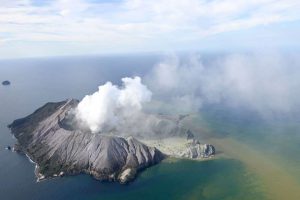DECEMBER 16, 2019

WHAKATANE, NEW ZEALAND — When Phil van Dusschoten retired as a police officer and started a diving business 24 years ago, the next chapter of his life seemed set, steering visitors through the stunning Bay of Plenty to frolic with dolphins and swim around the volcanic White Island.
That life and livelihood have been on pause since an eruption last Monday fired toxic gas and molten rocks into the air and engulfed the island in ash. Eight people died on the island and another eight have since succumbed to their wounds. Two others remain missing.

An operation to recover bodies from White Island on Friday.
Now the country is wondering about the economic aftershocks.
“People come to New Zealand because they expect to be challenged like this, to see if you have the nerve to step outside your comfort zone,” Mr. van Dusschoten said. “We hope that doesn’t go away.”
The tragedy has set off an intense debate among New Zealanders about tourism, including whether nature is being wrongly exploited for thrills and whether enough precautions are being taken.
Many wonder whether the disaster will ruin adventure tourism for New Zealand. The country has a famed marketing campaign, “100% Pure New Zealand,” which includes ads filled with people rappelling down cliffs, helicopter snowboarding and white-water rafting — but also has a legal system that makes it hard to sue when things go wrong.
The concerns echo those in other nations where tourism can be lucrative but treacherous. Nepal considered new safety rules for Mount Everest this year after one of its deadliest climbing seasons ever, and as more visitors flock to sites like Chernobyl in Ukraine and Fukushima in Japan, the authorities are facing more questions about the safety of so-called dark tourism.
New Zealand has much at stake. Tourism is the country’s biggest export, representing nearly 6 percent of its economic output, roughly double the industry’s share of the economies of Australia and the United States.
And the business is booming. In a country where growth is hard to find, tourism revenue has soared 50 percent over the past six years, according to government figures. The industry directly or indirectly employs more than 14 percent of the work force, providing 393,279 jobs last year.
The people of Whakatane, the town closest to White Island, have been processing Monday’s explosion with shock, anger and fear.
Radio stations heard from callers who recounted stories of their riskiest trips and complained that more regulation would turn New Zealand into a nanny state. Employees in outdoor equipment stores worried that with White Island temporarily off limits, tourists would stop coming. Some residents accused tour operators of putting profits before safety, suggesting that they had ignored warnings about increased seismic activity.
Whakatane has no jurisdiction over the island, which is privately owned and comes under the mandate of New Zealand’s Department of Internal Affairs. But their fates are inextricably intertwined.
Mayor Judy Turner called the island the “anchor” of the town, saying in an interview, “It is still the backbone of our economy, and there would be an impact if it’s closed to the public.”
A sudden drop in overseas visitors is not her greatest concern. Around 80 percent of tourism to Whakatane is domestic, she said, suggesting that interest will not disappear. “It’s a place where New Zealanders come for a holiday,” she said.
Along the Bay of Plenty, with the volcano visible in the far distance, sits the local marae, the communal meeting place for Whakatane’s Maori people. The Ngati Awa tribe lives here, and even with people of its own missing on the island this past week allowed foreign families with lost loved ones onto its sacred ground.
One tribal leader, Pouroto Ngaropo, said the explosion was the island’s response to being exploited for money.
“I think she’s had enough of tourism,” he said of Whakaari, the Maori name for White Island. “They make millions off her a year, that’s the real issue.
People have lost sight of the meaning of nature and its beauty, he said, and are focused on shallow experiences.
“If we don’t listen, and then it keeps occurring, then what?” he said. “At least I can say I gave my message, and if anyone continues on the same path and others keep dying, I’ve told you so. Not me, she did.”
The tribe has placed a spiritual ban on the island and its surrounding waters, barring any fishing or maritime activity until the dead are accounted for.
White Island’s owners, three brothers who inherited the volcano after it was bought in 1936 by an Auckland stockbroker named George Raymond Buttle, issued a statement asking that the spiritual ban, or rahui, be respected. With the two people still missing, it seems likely to stay in place.
The police on Sunday confirmed the deaths of two brothers — Matthew Robert Hollander, 13, and Berend Lawrence Hollander, 16, United States citizens who lived in Australia — and of Karla Michelle Mathews, 32, of Australia, in the eruption.
They have also named as among the dead four Australians — Krystal Eve Browitt, 21, Zoe Ella Hosking, 15, and Gavin Brian Dallow, 53, and Anthony James Landford, 51 — and a New Zealander, Tipene Maangi, 24.
Maintaining a moratorium on tourism on White Island for any stretch of time could prove difficult. It has been featured for years along with other destinations in the country’s adventure tourism marketing.
Prime Minister Jacinda Ardern, who faces elections next year, has been vague about whether that approach to tourism needs to change and whether the volcano should be off limits.
“We hear, and we absolutely agree, that there are questions that have been asked and must be answered,” she said on Friday. She also noted that White Island was a “volcano that’s been visited for the better part of 30 years” without serious misfortune.
New Zealand’s legal system encourages a culture of risk-taking, experts say. It has a “no fault” framework that bars personal injury lawsuits in favor of a government compensation process for accidents, largely protecting businesses from the threat of large payouts.
“We have no court cases now for negligence or injury from motor vehicles, aircraft crashes, hot coffee, slipping over,” said Tim Mackenzie, a health and safety lawyer in Christchurch. People can sue for damages, he said, “but it is a very high test, rarely if ever met.”
In Whakatane, many argue that a dash of danger is what people want. Even as boat rides, helicopter jaunts and other outdoor activities were suspended, Mr. van Dusschoten said he and other tour operators had fielded calls all week from people around the world who still wanted to visit.
One woman, he said, conveyed that she had visited volcanoes in Hawaii and wanted to get close to White Island “to feel the fury.”
Mr. van Dusschoten insisted, as did many other New Zealanders, that what happened on Monday was unpredictable, the first natural catastrophe of its magnitude in decades of adventure tourism. The last time anyone died on White Island was in 1914 when part of a crater wall collapsed, killing 10 miners.
Danger is part and parcel of New Zealand’s attraction, he said. “We do white-water rafting — there are places here you can go off a waterfall. Thousands of people do it, and you might have a drowning or two,” he said. “People walk on a glacier that could collapse at any time.”
Mr. van Dusschoten added, “It’s all risky stuff, but honestly, that’s what a lot of tourists demand these days, especially the young ones.”
Courtesy/Source: NY Times











































































































